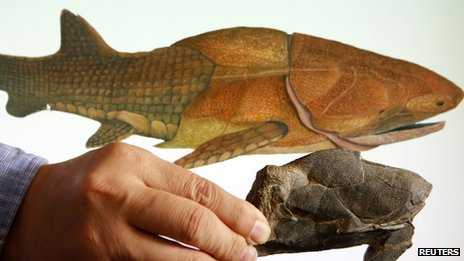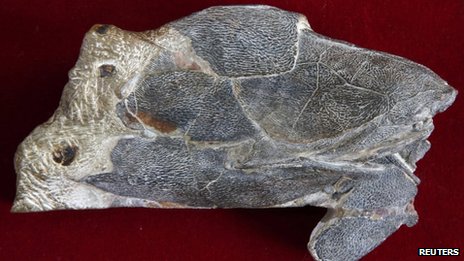A leading British scientist has said that the discovery of a 419-million-year-old fish fossil in China is a stunning and spectacular development.
Palaeobiologist Matt Friedman told the BBC that the fish provided crucial evidence about the evolutionary development of jawed vertebrates.
As a remote relative of humans, it provides important evolutionary clues.
“It is the deepest branch of our family tree that bears the kinds of jaw bones found in humans,” Dr Friedman said.
The fossil was found at China’s Xiaoxiang Reservoir, and was reported by the journal Nature on Thursday.

Entelognathus primordialis had a heavily armoured head and body, a scaly tail, jaws but no teeth and tiny eyes set in large, bony sockets
Scientists say that the heavily armoured fish, Entelognathus primordialis, is a previously unknown member of jawed vertebrates also known as gnathostomes. It has a complex small skull and jaw-bone structure.
“This is an unexpected discovery that inverts schoolbook teaching on the evolution of bony skulls,” Dr Friedman told the BBC.
“Up until now it had been thought that the anatomical peculiarities of bony fishes – the group that would eventually give rise to human beings – are specialisations that arose later in vertebrate evolutionary history in our own bony fish lineage.”
“But now that narrative has been turned on its head.”
Dr Friedman said that the fish’s jaw was much more like that of a modern bony fish – which is why its discovery may offer a new perspective on the early evolution of these creatures.
His review of the significance of the fossil find also appears in the latest edition of Nature.

The fossil of Entelognathus primordialis, in front of a computer screen showing a life restoration image
Scientists say that the evolution of jaws is one of the key episodes in the evolution of vertebrates, but the gap between jawed and jawless vertebrates is so large that it is hard to work out the individual evolutionary steps in the transition.
“While this fossil does not tell us anything about the origin of jawed fishes from jawless ones, it does tell us about subsequent modifications to jaw structure that we thought were unique to bony fishes,” Dr Friedman said.
It is thought that modern jawed vertebrates, such as sharks and bony fishes, emerged from a collection of jawed, armoured fishes known as placoderms.

Dr Friedman says that the discovery of the fossil is a significant advance in our understanding of evolution
Entelognathus primordialis has jaw-bone features previously restricted to bony fishes (osteichthyans) as well as full body armour seen in placoderms, and it would have been around 20cm (7.8in) long.
Dr Friedman says that the fossil adds weight to the theory that many classic bony fish features were evolved “very deep in our family tree, before bony fish split from sharks”.
“This means that we – as in bony fishes – are the ones who have held on to more ancient structures, while it is the sharks that have gone off and done something new and interesting in an evolutionary sense.
“They are the ones that have most radically modified this pattern, which we now understand is probably primitive to all modern jawed vertebrates.”



 September 30th, 2013
September 30th, 2013  Riffin
Riffin  Posted in
Posted in  Tags:
Tags: 